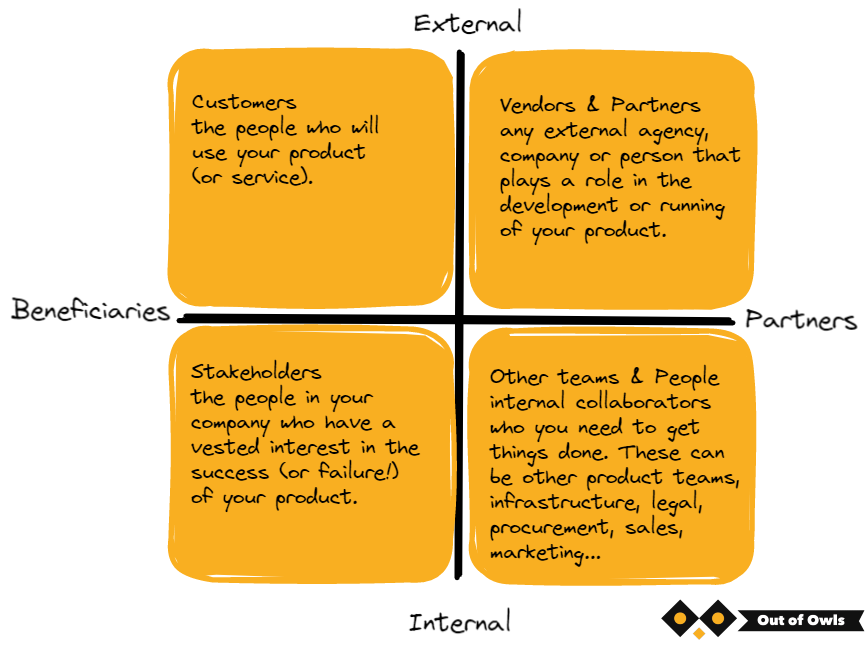Stakeholder Motivation mapping: an Introduction
“People,” Janna Bastow likes to say, “are hard.” Agreed. In fact the only thing harder than managing people is managing lots of people.
One of the hardest parts of product management is understanding who wants what, why, and when. This goes for people both internal and external to your company - and getting straight answers from any of them can be tricky. The biggest issue that’s come up for me is when I believe that I already know the answers. That’s usually where the biggest issues come from.
To rectify that, I now do a round of Stakeholder Motivation Mapping at the beginning of new engagements or projects - or anytime that things aren’t going so well. This isn’t a formal phase - it’s a simple way of reviewing my relationships and the expectations for the work that the team is doing. It’s an invaluable resource for the way that we communicate, prioritise and collaborate.
Here’s how it works:
1. Talk to your key stakeholders and partners.
That means the people you’re responsible to and your partners - but let’s review who that is, exactly, and what to talk to them about.
EXTERNAL + BENEFICIARIES / Customers - the people who will use your product (or service).
EXTERNAL + PARTNERS / Vendors & Partners - any external agency, company or person that plays a role in the development or running of your product.
INTERNAL + BENEFICIARIES / Stakeholders - the people in your company who have a vested interest in the success (or failure!) of your product.
INTERNAL + PARTNERS / Other teams & People - internal collaborators who you need to get things done. These can be other product teams, infrastructure, legal, procurement, sales, marketing (etc)...
2. Ask them about what their definition of success is for your efforts.
Why do they need it? When do they need it? How much of a priority is it for them? What happens to them if it doesn’t happen, or doesn’t happen when expected?
You can find out a *lot* from this. Does their bonus rely on you delivering something? Does their boss’ scorecard depend on it? Or does it really not matter to them much at all?
Make sure you write down or record their answers. This is critical.
3. Now it’s time to do the same thing we always do after a round of research: synthesis.
Take a look at the different motivations that people have and group them together.
4. Next comes analysis
We need to understand if the motivations align or if there’s any conflict on the horizon. Most of the issues I’ve had come from conflicts amongst two different parties that I - or my team - is caught in the middle of. Knowing about this conflict is the first step in solving it.
I’ve been asked about how to visualise this step, and I don’t (yet!) have a formal approach. At this point, it’s still based on the situation - though a 2x2 matrix often comes in handy to help explain the dilemma to other people.
5. Not that resolving the conflict is easy, mind you.
Sometimes it’s not even possible - or at least, not possible for you to do so. Here’s a few ways to approach it:
Ensure that you have the right understanding of the situation. That’s why asking what the priority of something is to people is critical - things that come across as Must Haves might not be critical at all, or might be solved in a different way.
See if you can resolve it yourself. On occasion, this isn’t much of an issue - different people may not be aware of demands being put on you by other parties, and a simple discussion can make a massive difference. A stakeholder or partner may be able to make a change or resolve the issue easily, by providing people or resources or by changing or dropping a demand.
Bring people together. Being stuck in the middle of two (or more!) parties asking for conflicting things is an awful place to be - so remove yourself from that position by facilitating a discussion or negotiation to change the circumstance.
Escalate the issue. As much as I hate relying on tools like a RACI matrix, sometimes the only way out is get someone at a higher level - usually your Accountable person - to raise the issue at a more senior forum. This may feel like admitting defeat in places with low psychological safety, but it’s actually a great opportunity to show leadership and demonstrate your strategic thinking in healthier environments. Just keep in mind that means you must show up with a clear analysis and recommendations based on the opportunities, impacts and outcomes - not just play Chicken Little and shout that “the sky is falling!”
If you make use of this approach - or if you have a neat way of visualising the analysis stage - let me know!


